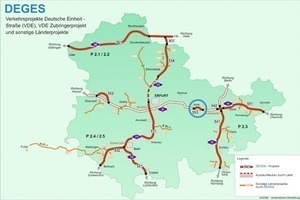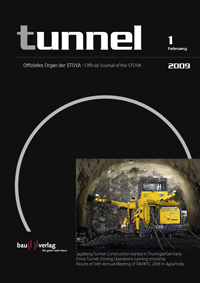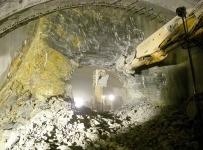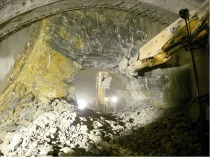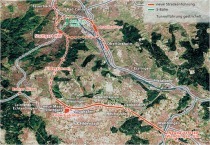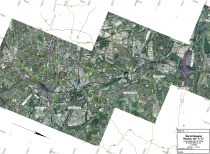Construction started on the Jagdberg Tunnel in Thuringia/D
GermanyWith the start of construction of the Jagdberg Tunnel as part of the A 4 federal motorway through the Leutratal in Thuringia/D an important step towards eliminating a bottleneck began in March 2008. The A 4, an essential west-east axis on a European scale, is to be further developed here.
The Eisenach–Görlitz A 4 federal motorway is highly significant as an important west-east axis in the German and European highway network (European highway E 40). It connects the East German centres with the Rhein-Ruhr district and the Rhine-Main region in the west and the Polish industrial centres in the east. With Poland’s EU entry in 2004 and Romania and Bulgaria joining in 2007, its importance as a European artery has been strengthened even further. Regarding its function as a development and relief transport axis the A 4 is the most important in the Free State of Thuringia alongside the A 9. On account of this great significance and the high increase in the growth of traffic since the Fall of the Wall, the redevelopment of the old motorway link over a distance of some 387 km – from the Wommen/Hesse autobahn hub to the federal border with Poland at Görlitz –was described in 1992 as an “imperative requirement” and included as Project No. 15 in the catalogue of German Unity Transport Projects (VDE) – Road. The DEGES – Deutsche Einheit Fernstraßenplanungs- und -bau GmbH is tackling the planning and construction of 215 km of the A 4 (Fig. 1).
Inadequate Traffic Conditions
The route of the existing A 4 – planned and built during the 1930s – no longer conforms with the existing codes of practice in a number of respects. The adapting of the route alignment to the winding topography of the Leutratal resulted in very long and in part extremely sloping inclines. For instance a difference in altitude of 225 m has to be overcome with the 9.5 km long ascending slope between the Saalebrücke near Jena and the Amselberg at Schorba. Whereas a continuous average gradient of 2.5 % prevails over roughly 7 km, the gradient at the Amselberg amounts to 6 % in both directions of travel (a maximum of 4.5 % is permissible for a new project). The speed of lorries drops significantly to the so-called “sustained speed on an upward gradient”, as a result of which the traffic flow is substantially affected. The risk of accidents is then especially large particularly given inclement weather conditions in winter.
The current 4-lane cross-section which is without proper hard shoulders or none at all certainly does not comply with the required standard in order to assure an undisturbed flow of traffic given the current volume of more than 50,000 vehicles/
24 h. Such deficits are backed up by an over-average incidence of accidents with in some cases serious consequences. On account of their proximity to the existing motorway and the previously mentioned circumstances, the impact caused by noise and harmful substances for certain residential areas as well as for affected nature conservation, FFH and EU bird protection areas is extremely high. By removing the motorway from the ecologically sensitive Leutratal region in conjunction with the construction of the roughly 3 km long “Jagdberg Tunnel” an extreme bottleneck that is subject to disturbances will be removed on the A 4 in the Free State of Thuringia. With the subsequent renaturation of the old route flora and fauna will be given back invaluable living space. The DEGES has been commissioned with the planning and building of the
11.8 km long new section (including the Jagdberg Tunnel and the Bucha southern bypass).
A look at traffic developments underlines the necessity for eliminating the bottleneck on the A 4 between Magdala and Jena as quickly as possible (Fig. 2). Taking the 6-lane expansion for the adjacent sections to the west and east into consideration if the development measure was not executed this would mean that the average traffic frequency in the Leutratal in 2015 would rise to approx. 57,000 vehicles/24 h. With the expansion of the A 4 to 6 lanes to the north of the Leutratal, a forecast load of some 83,000 vehicles/24 h given an approx.
18 % proportion of lorries results for this section. With more vehicles in a position to be able to use the motorway the surrounding highway network will be substantially relieved. For the residents of local cross-town links – above all as part of the B 7 and the B 88 – this signifies considerably less impact caused by noise and harmful substances and a reduction in the risk of accidents.
On account of the complicated topographical and ecological circumstances in and around the Leutratal extremely extensive investigations had to undertaken in order to come up with the optimal solution with regard to traffic efficiency, regional planning, ecology and economy. Within the scope of the regional planning procedure (ROV) a large number of variants were worked out and compared with each other. A zero variant, in other words retaining the current route alignment was discarded after initial examinations as it proved only to produce disadvantages regarding all important assessment criteria (traffic, safety, relief, nature and environment, regional planning) and thus failed to provide a sensible alternative for any further planning.
New Construction Variants
Within the scope of new construction variants 10 route variants were worked out within a corridor of roughly 2 km to the north of Leutra (in some cases with sub-variants). In the course of a comparative examination 2 new construction variants (each including the production of a tunnel) emerged as advantageous solutions. After further in-depth investigations the “Jagdberg” variant with the approx. 3 km long tunnel received the green light.
Jagdberg Tunnel Startup
On September 25th, 2008 the startup for the Jagdberg Tunnel took place at the east portal, which is located near Jena-Göschwitz on the valley slope of the Saale. The embankment cutting in front of the portal is located immediately next to the very busy A 4 motorway. Earthworks have been visible from afar for motorway users since April 2008 when passing over the new bridge crossing the Saale driving west on the upward gradient nearing the Leutratal. Currently the historic motorway bridge over the Saale is being renewed and traffic in an east-west direction threads through the bottleneck of the at present single-tube Lobdeburg noise abatement barrier and over the second new bridge in 2-lane 2-way traffic at a highly reduced speed.
It is planned to remove all restrictions in 2012 so that the busy transit traffic can flow smoothly over 3 lanes in each direction – east and west. The overall costs for the project including substantial earth and highway tree works mainly in the west to link up with the A 4 at Magdala, which already has
6 lanes amount to roughly
€ 295 mill.
Route Alignment for the “Jagdberg” Variant
To the east of the Magdala motorway hub the new route branches off from the old one and then runs at a distance of on average 1.3 km to the north of the existing A 4 prior to returning to the old highway directly before the Jena/Gösch-witz hub (Fig. 4). Altogether the new route alignment is substantially longer than the existing one. The maximum longitudinal slope on gradients only amounts to 3.7 % (2.9 % in the tunnel).
Nature Protection Area of European Significance
In this particular case the environmental compatibility test (UVP) enjoys particular significance as the entire region around the Leutratal represents a highly sensitive and protection-worthy natural habitat: the existing nature protection area (NSG) “Leutratal”, which is intersected by the existing route of the A 4 possesses 27 proven forms of orchids making it one of the most important regions for rare orchids in Germany. The “Leutratal – Cospoth – Schieß-platz Rothenstein” area was declared a Special Area of Conservation (SAC) by the EU at the end of 2004 and with an overall area of some 1,650 ha living space for endangered animals and plants. The EU bird protection area “Muschel-
kalkhänge der westlichen Saaleplatte”, registered with the EU Commission in spring 2007, is almost identical with the previously mentioned SAC.
The chosen preferred route with the Jagdberg Tunnel provides long-lasting relief for these protected areas through the building of an around 3 km long tunnel while at the same time the existing route is renaturised and traffic is completely removed from this area. In this way the separating effect resulting from the existing route will be completely removed in this ecologically important natural habitat.
Accompanying Landscape Conservation Plan
Far-reaching compensatory and alternative measures were worked out for inevitable interference with nature and landscape, caused by the building, setting up and operation of a motorway and recorded in the accompanying Landscape Conservation Plan (LBP). The nature and location of the measures depend on the functional losses resulting from intervention and on the development requirement of the surrounding area. Particular attention is paid to ensure that these measures are spatially and functionally related with existing or affected elements of nature and landscape. This has taken place in close collaboration with the nature conservation authorities and in keeping with the valid nature conservation laws.
The negative effects resulting from the new construction of the A 4 in the Leutratal are being compensated for by alternative measures over an area of around 140 ha. These measures include:
M Renaturation of the existing highway in conjunction with neighbouring biotope structures
M Planting trees in the beech and mixed deciduous woodlands
M Exposure of the Leutra spring and extensifying agriculture.
In addition there are some 80 ha of landscaping measures to integrate the new highway into the landscape.
Jagdberg Tunnel
The major structure on the almost 12 km long new section of the A 4 between Magdala and Jena/Göschwitz is the roughly 3 km long Jagdberg Tunnel. Essentially the tunnel solution represents the least possible intervention in the ecologically sensitive area by operating the motorway.
Geology
Investigatory drilling revealed that the higher situated part of the tunnel in the west mainly lies in shell limestone and the section dipping to the east, separated by a fault zone, is located in upper bunter sandstone (Fig. 5).
Fault zones were also encountered at the planned portal zones. Altogether the geological conditions cater for a vault with open floor over roughly
80 % of the length of the tunnel (Fig. 6). A base invert is only required at the portal zones and in the fault zone.
Structural Design
The tunnel’s alignment is governed by the topographical conditions as well as by the neighbouring nature conservation areas (FFH) (Fig. 7).
Given a maximum overburden of approx. 140 m the 2 separate tubes run parallel with a centre distance of roughly 21 m and are to be connected with one another via 10 cross-passages at 280 m gaps. In addition, 2.50 wide emergency lay-bys will be set up at 560 m gaps.
Each tube possesses 3 lanes each 3.50 m wide as well as
1.00 wide emergency pathways. The east and west portals are secured by a supporting wall; the operational buildings are set up in the portal zones.
Excavation and Lining
The 2 tubes and the cross-passages are driven by mining means. Cut-and-cover however is applied in the portal zones over roughly 130 m (east) and around 10 m (west).
On account of the geological conditions that were encountered the Jagdberg Tunnel is being produced by the NATM. In keeping with this method the cavity is driven in short lengths by drill + blast. The exposed area is supported and secured immediately with shotcrete, reinforcement and anchors against the rock caving in.
The tunnel drainage is basically a separate system. On account of the geological-hydrogeological conditions a drained tunnel with an umbrella seal is being executed. Towards this end the inner shell is sealed by means of plastic waterproofing membranes. The water running through the tubes sealed in this manner is fed into drainage lines in both directions and transferred to the collector via the tunnel gradient. The carriageway is drained via slotted gutters and separate pipelines into a collecting basin. The roughwork is rounded off by the building of a 40 to 50 cm thick concrete inner shell, which assures that that the structure is permanently stable. It is completed by installing the operating and safety installations as well as the carriageways (Figs. 8 and 9).
Tunnel Safety
The aspects of operational safety are accorded top priority from the very start in modern tunnelling in Germany. Through the installation of 10 cross-passages, every second one of which can accommodate rescue vehicles, the maximum escapeway length amounts to only 300 m in the event of an emergency. The cross-passages are closed by means of fire protection doors. Emergency and fire extinguishing facilities are installed at approx. 140 m gaps; both tubes are entirely monitored by video camera. In order to optimise escapeway identification even further it is intended to install an active guidance system along the side.
Ventilation Concept
On account of the length of the Jagdberg Tunnel a complex ventilation system is required, which regulates the exchange of incoming and outgoing air, minimises the impact of harmful substances at the portals and also functions optimally in the event of fire. Each tube is divided into 2 ventilation sections in order to assure this. Towards this end an approx. 140 m high exhaust air shaft is produced in the middle of the tunnel by means of which fire gases are removed from one half of the affected tunnel tube in case of fire so that it is prevented that the entire tube is filled with smoke. In standard mode a mechanical longitudinal ventilation caters for the required intake and exhaust ventilation of the tunnel using jet fans. A part of the exhaust air can also be removed in standard mode via the exhaust shaft from both tubes at the same time.
Supporting Walls
In the area in front of the west portal the route is located in a deep 14 to 28 m cutting. In order to reduce the amount of excavated earth and intervention into nature and the landscape the building of 2 supporting walls – 750 m long and 12 m high as well as 470 m long and
6 m high – stepped by a berm is foreseen.
Two supporting walls are to be built adjoining the east portal – 1,072 m long and 8 m high (carriageway towards Eisenach (as well as 207 m long and 5 m high (carriageway leading to Görlitz).
The supporting walls will be devised as steeply sloping dry walls with large-size, coarsely worked natural stones (Fig. 10).
Start of Construction
The construction of the Jagdberg Tunnel including the earth, drainage and ceiling works was commissioned on March 20th, 2008 after a 1-year delay. This resulted from complaints against the plan approval resolution decided on in February 2007. The federal administrative court rejected the urgency applications against the construction project in March 2008 so that the contract could be awarded.
Construction will be carried out by the Baresel Beton- und Monierbau/Kirchhoff JV. The structural plan and the compilation of the tendering documents for the Jagdberg Tunnel were undertaken by the Büro WBI Prof. Wittke Aachen/D. The client has commissioned an Ingenieurgemeinschaft comprising the offices Bung, Heidel-berg/D and Müller + Hereth, Freilassing/D (supported by the Ingenieurgruppe BEB, Weimer/D) for building the route) to take charge of the general management and supervision for the complex overall construction scheme.
In addition to the tunnel the construction of the route (building roughly 8.7 km of a new
6 lane federal motorway section/with 3.9 mill. m³ of earth being moved) and the setting up of 2 bridges are included in the overall scheme. The JV will find itself faced with a logistic challenge during the construction measure, which calls for the harmonisation of the tasks running parallel and interlinking with each other as part of the overall project. These include for example the fact that bulk transportation is by and large only permitted in the site and route area so that the required transportation of earth must be carried out through the tunnel during the construction period.
A further challenge posed by this construction project, which is due to be completed in the autumn of 2012 and then opened for traffic: guidance phases for traffic in the adjoining areas and the tunnel accesses with the traffic flowing over the A 4 in addition to adhering to nature conservation requirements.

